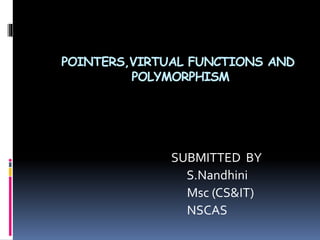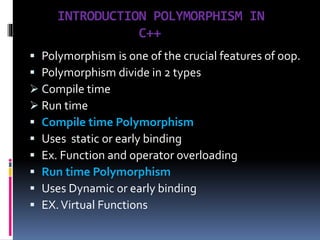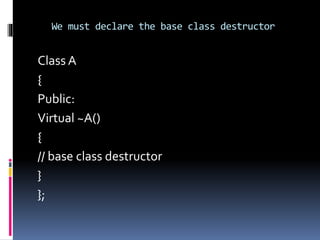pointer, virtual function and polymorphism
- 1. POINTERS,VIRTUAL FUNCTIONS AND POLYMORPHISM SUBMITTED BY S.Nandhini Msc (CS&IT) NSCAS
- 2. SYNOPSIS Introduction Pointers Pointers to objects This pointer Pointer to derived classes Virtual functions Virtual constructors and destructors
- 3. ACHIEVING POLYMORPHISM polymorphism Compile time Run time Function overloading Operator overloading Virtual functions
- 4. Function overloading: An overloaded function can have multiple definitions for the same function name in the same scope. Function declarations cannot be overloaded if they differ only by return type. Operator overloading: It is one of the many exciting features of c++. important technique that has enhanced the power of extensibility of c++. Virtual functions: we use pointer to base class to refer to all the derived objects.
- 5. INTRODUCTION POLYMORPHISM IN C++ Polymorphism is one of the crucial features of oop. Polymorphism divide in 2 types Compile time Run time Compile time Polymorphism Uses static or early binding Ex. Function and operator overloading Run time Polymorphism Uses Dynamic or early binding EX.Virtual Functions
- 6. COMPILE TIME POLYMORPHISM Function overloading is an example of compile time polymorphism This decision of binding among several function is taken by considering formal arguments of the function , their data type and their sequence.
- 7. RUN TIME POLYMORPHISM It is also known as dynamic binding, late binding and overriding as well It provides slow execution as compare to early binding because it is known at run time Run time polymorphism is more flexible as all things execute at run time.
- 8. RUN TIME POLYMORPHISM For Example: Class A { int x; public: void show() {…..} }; class B : public A { int y; public: void show() {…..} };
- 9. POINTERS Pointer is a derived data type that refers to another data variable by storing the variable’s memory address rather than data. Pointer variable can also refer to (or point to) another pointer in c++.
- 10. DECLARING AND INITIALIZING POINTERS The declaration is based on the data type of the variable it points to. The declaration is based on the data type of the variable takes the following form Syntax: data-type *pointer –variable; Let us declare a pointer variable, which points to an integer variable Int * ptr; we can initialize a pointer Int* ptr ,a; // declaration Ptr=&a; // initialization
- 11. EXAMPLE OF USING POINTERS #include <iostream.h> #include <conio.h> Void main() { Int a,*ptr1,**ptr2; Clrscr(); Ptr1=&a; Ptr2=&ptr1; cout <<“The address of a :”<<ptr1<<“n”; C 0ut <<“The address of ptr1 :”<<ptr2; Cout <<“nn”; Cout <<“after incrementing the address values:n”; Ptr1+=2; cout <<“The address of a :”<<ptr1<<“n”; Ptr2+=2; Cout <<“The address of ptr1 :”<<ptr2<<“n”; } Output: The address of a:0xfb6fff4 The address of ptr1:ox8fb6ff2 After incrementing the address values: The address of a:ox8fb6fff8 The address of a:ox8fb6fff6
- 12. MANIPULATION OF POINTERS We can manipulate a pointer with the indirection operator ,i.e.,’*’which is also known as dereference operator. Syntax: *pointer_variable
- 13. MANIPULATE OF POINTERS #include<iostream.h> #include<conio.h> Int main() { Int a=10; Int *ptr; Clrscr(); Ptr=&a; Cout<<“the value of a is:”<<*ptr; *ptr=*ptr+a; // manipulate Cout<<n the revised value of a is”<<a; getch (); return o; } Output: The value of a is:10 The revised value of a is:20
- 14. POINTER EXPRESSIONS AND POINTER ARITHMETIC A pointer can be incremented(++) or decremented(--) Any integer can be added to or subtracted from a pointer One pointer can be subtracted from another Example: int a[6]; int *aptr; aptr=&a[0]; We can increment the pointer variable aptr++ (or) ++aptr We can decrement the pointer variable aptr-- (or) --aptr
- 15. USING POINTERS WITH ARRAY AND STRINGS Pointer is one of the efficient tools to access elements of an array. We can declare the pointers to array Int *nptr; nptr=number[0]; nptr points to the first element of the integer array, number[0]. float*fptr; fptr=price[0];
- 16. ARRAY OF POINTERS The array of pointers represents a collection of addresses. An array of pointers point to an array of data items. We can declare an array of pointers as int *inarray[10];
- 17. PROGRAM ARRAY OF POINTER #include<iostream.h> Const int MAX=4; Int main() { Char*names[100]={“priya”,”nathiya”,”riya”,”sri”,”chitra”}; For (int i=0;i<100;i++) { Cout<<“value of names[“<<i<<“]=“; Cout<<names[i]<<endI; } return 0; }
- 18. POINTER AND STRINGS There are two ways to assign a value to a string We can use the character array or variable of type char*. char num[]=“one”; const char*numptr=“one”;
- 19. THIS POINTER This unique pointer is automatically passed to a member function when it is called The pointer this acts as an implicit argument to all the member functions This pointer is an implicit parameter to all member functions.
- 20. EXAMPLE FOR THIS POINTER Class className { Private: int dataMember; Public: Method(int a) { //This pointer stores the address of object obj and access dataMemberThis -> dataMember=a; … … .. } } int main() { className obj; Obj.method(5); ….. … … }
- 21. Pointers to objects of a base class are type compatiable with pointers to objects of a derived class A single pointer variable can be made to point to objects belonging to different classes. POINTER TO DERIVED CLASS
- 22. VIRTUAL FUNCTIONS A virtual function is a member function of class that is declared within a base and re-defined in derived class. Syntax: virtual return_type function_name() { …….. …….. }
- 23. RULES OF VIRTUAL FUNCTIONS Virtual functions are created for implementing late binding The virtual functions must be members of some class . They cannot be static members. They are accessed by using object pointers. A virtual function can be a friend of another class.
- 24. Difference between virtual and pure virtual Functions BASIS FOR COMPARISON VIRTUAL FUNCTION PURE VIRTUAL FUNCTION Base ‘virtual function’ has their definition in the base class ‘pure virtual function’ has no definition in the base class. Declaration Funct_name(parame ter_list){….}; Virtual funct_name(parameter_list)=0; Derived class All derived classes may or may not override the virtual function of the base class All derived classes must override the virtual function of the base class.
- 25. PURE VIRTUAL FUNCTIONS A function virtual inside the base class and redefine it in the derived classes. for ex. we have not defined any object of class media and therefore the function display(). The base class has been defined ‘empty’. Virtual void display()=0;
- 26. PURE VIRTUAL FUNCTION REAL WORLD EXAMPLE int main() { Shape*sptr; Rectangle rect; Sptr=& ret; Sptr->set_data (5,3); Cout<<“area of rectangle is”<<sptr->area()<<endl; Trangle tri; Sptr=&tri; Sptr->set_data(4,6); Cout<<“area of triangle is”<<sptr->area()<<endLl; Return 0; }
- 27. VIRTUAL CONSTRUCTORS AND DESTRUCTOR “A constructor can not be virtual “.there are some valid reasons that justify this statement First to create an object the constructor of the object class must be of the same type as the class. Class declarations that make use of destructors class A { public: ~a() { // base class destructor } }; class B:publicA { public: ~b() { //derived class destructor } }; Main() { A* ptr=new B(); . . Delete ptr; }
- 28. We must declare the base class destructor Class A { Public: Virtual ~A() { // base class destructor } };
- 29. Thank you













![POINTER EXPRESSIONS AND POINTER
ARITHMETIC
A pointer can be incremented(++) or decremented(--)
Any integer can be added to or subtracted from a pointer
One pointer can be subtracted from another
Example:
int a[6];
int *aptr;
aptr=&a[0];
We can increment the pointer variable
aptr++ (or) ++aptr
We can decrement the pointer variable
aptr-- (or) --aptr](https://image.slidesharecdn.com/nandy-170915125622/85/pointer-virtual-function-and-polymorphism-14-320.jpg)
![USING POINTERS WITH ARRAY AND
STRINGS
Pointer is one of the efficient tools to access
elements of an array.
We can declare the pointers to array
Int *nptr;
nptr=number[0];
nptr points to the first element of the integer
array, number[0].
float*fptr;
fptr=price[0];](https://image.slidesharecdn.com/nandy-170915125622/85/pointer-virtual-function-and-polymorphism-15-320.jpg)
![ARRAY OF POINTERS
The array of pointers represents a collection
of addresses.
An array of pointers point to an array of data
items.
We can declare an array of pointers as
int *inarray[10];](https://image.slidesharecdn.com/nandy-170915125622/85/pointer-virtual-function-and-polymorphism-16-320.jpg)
![PROGRAM ARRAY OF POINTER
#include<iostream.h>
Const int MAX=4;
Int main()
{
Char*names[100]={“priya”,”nathiya”,”riya”,”sri”,”chitra”};
For (int i=0;i<100;i++)
{
Cout<<“value of names[“<<i<<“]=“;
Cout<<names[i]<<endI;
}
return 0;
}](https://image.slidesharecdn.com/nandy-170915125622/85/pointer-virtual-function-and-polymorphism-17-320.jpg)
![POINTER AND STRINGS
There are two ways to assign a value to a
string
We can use the character array or variable
of type char*.
char num[]=“one”;
const char*numptr=“one”;](https://image.slidesharecdn.com/nandy-170915125622/85/pointer-virtual-function-and-polymorphism-18-320.jpg)










